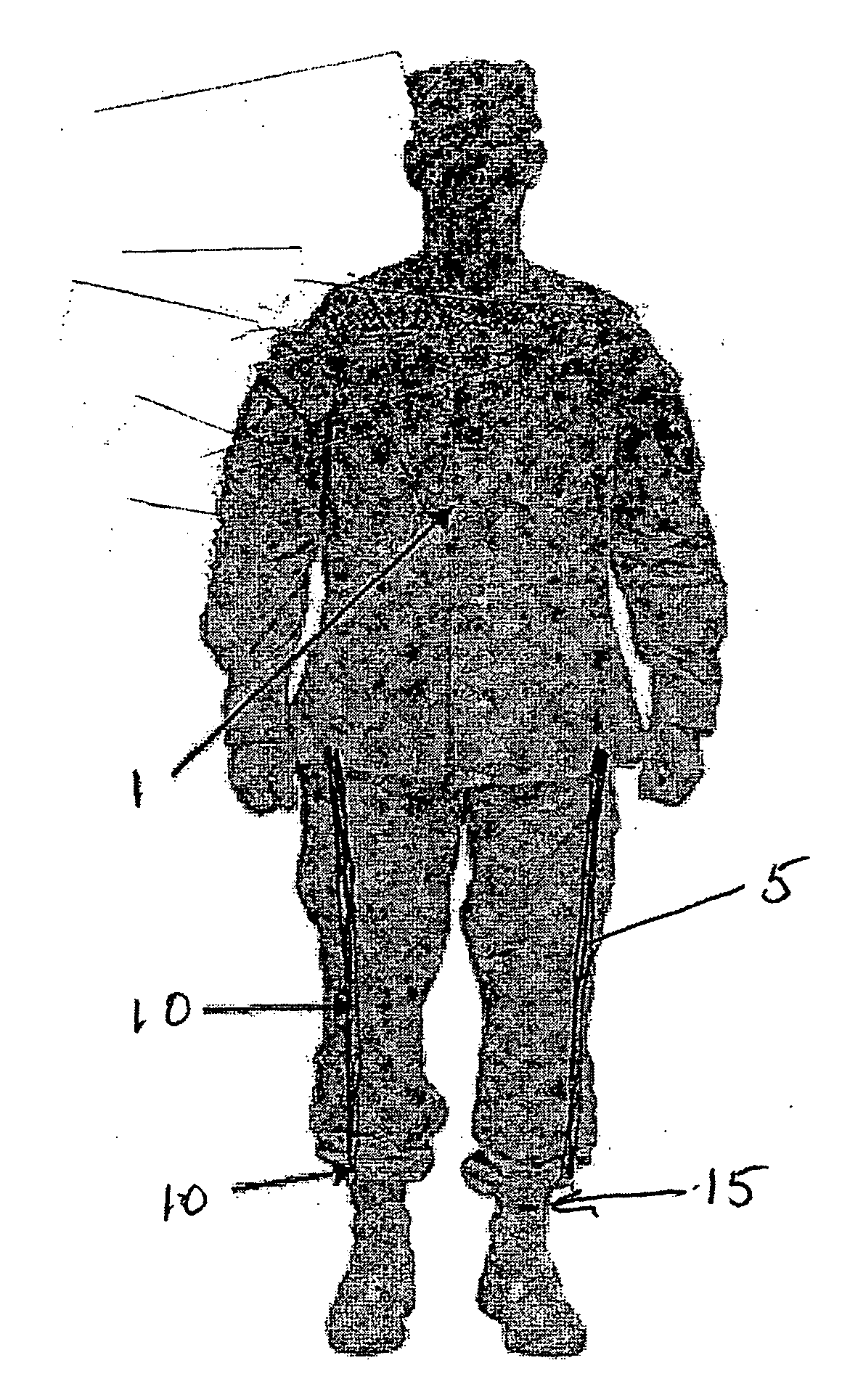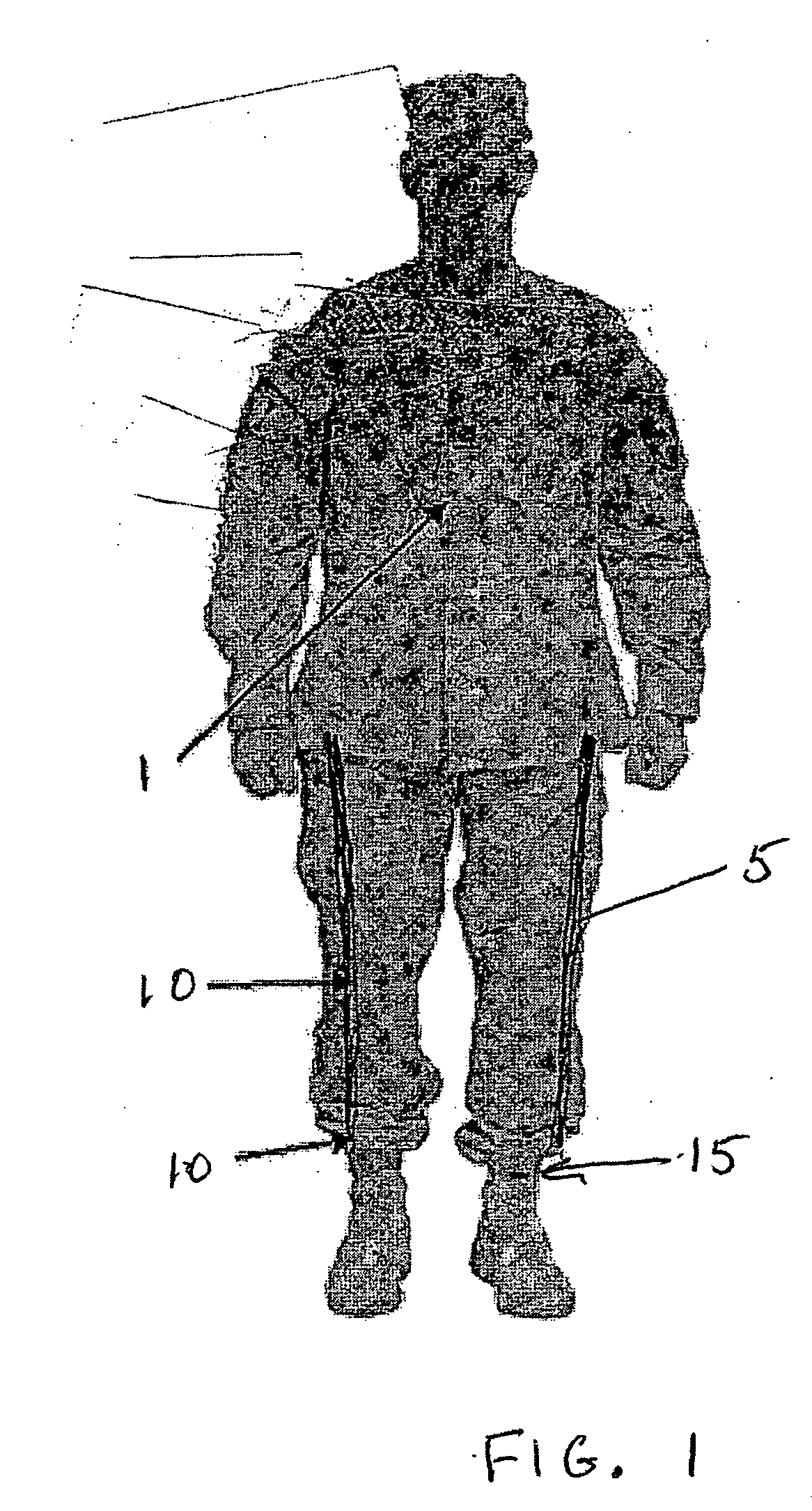Antistatic fabrics and anti-taser protective device
- Summary
- Abstract
- Description
- Claims
- Application Information
AI Technical Summary
Benefits of technology
Problems solved by technology
Method used
Image
Examples
first embodiment
[0024] The dyes can be formed from the following processes. The first embodiment uses multiwalled carbon nanotubes (MWNT) or double walled carbon nanotubes (DWNT) to make a dye comprising a carbon nanotubes dispersion and a dye mixture to dye a linen fabric.
[0025] Step 1: A dispersion of carbon nanotubes is formed by taking 20 mg of MWNT or DWNT to 40 ml of o-Xylene (HPLC grade, purity 96%). The nanotubes are selected such that the diameter is less than 30 nanometers and more preferably less than 20 nanometers. Then sonicate the solution using an ultrasonic disintegrator. One exemplary ultrasonic disintegrator is a SANYO MSE SONIPREP 150, which is available from Sanyo North America Corporation, San Diego, Calif. The SANYO MSE SONIPREP 150 is tuned to 23 kH and using one-quarter power for 5-10 minutes. Then heat the solution to 80C and sonicate it on high power for 30 minutes making sure that the o-Xylene level does not go below the 40 ml mark. If it does, then add more o-Xylene. Mon...
second embodiment
[0034] The second embodiment uses multiwalled carbon nanotubes (MWNT) or double walled carbon nanotubes (DWNT) to make a dye comprising a carbon nanotubes dispersion and a dye mixture to dye a linen fabric.
[0035] Step 1: A dispersion of carbon nanotubes is formed by taking 20 mg of MWNT or DWNT to 40 ml of o-Xylene (HPLC grade, purity 96%). The nanotubes are selected such that the diameter is less than 30 nanometers and more preferably less than 20 nanometers. Then sonicate the solution using a SANYO MSE SONIPREP 150 tuned to 23 kH and using one-quarter power for 5-10 minutes. Then heat the solution to 80C and sonicate it on high power for 30 minutes making sure that the o-Xylene level does not go below the 40 ml mark. If it does, then add more o-Xylene. Monitor the solvent temperature, remove it from heat and the sonicator and let the solution cool down. The suspension has been created. The carbon nanotubes will remain in suspension.
[0036] Step 2: The formulation of the indigo dye...
third embodiment
[0043] The third embodiment uses single walled carbon nanotubes (SWNT) to make a dye comprising a carbon nanotubes dispersion and a dye mixture to dye a linen fabric.
[0044] Step 1: A mixture of carbon nanotubes is formed by adding 0.056 grams of single walledcarbon nanotubes selected from a group where the average diameter is less than 30 nanometers and more preferably less than 20 nm, added to 20 ml of o-Xylene (HPLC grade, purity 96%) and 20 ml of O-Dichlorobebzene. This mixture is sonicated using a SANYO MSE SONIPREP 150 tuned to 23 kH and using high power for 30 minutes making sure that the o-Xylene level does not go below the 40 ml mark. If it does, then add more Xylene. Monitor the solvent temperature, remove it from heat and the sonicator and let the solution cool down. The suspension has been created. The SWNT's will remain in suspension.
[0045] Do not allow the temperature of o-Xylene to exceed 100C. Monitor the process closely and avoid inhaling the o-Xylene fumes when it ...
PUM
| Property | Measurement | Unit |
|---|---|---|
| Diameter | aaaaa | aaaaa |
| Diameter | aaaaa | aaaaa |
| Temperature | aaaaa | aaaaa |
Abstract
Description
Claims
Application Information
 Login to View More
Login to View More - R&D
- Intellectual Property
- Life Sciences
- Materials
- Tech Scout
- Unparalleled Data Quality
- Higher Quality Content
- 60% Fewer Hallucinations
Browse by: Latest US Patents, China's latest patents, Technical Efficacy Thesaurus, Application Domain, Technology Topic, Popular Technical Reports.
© 2025 PatSnap. All rights reserved.Legal|Privacy policy|Modern Slavery Act Transparency Statement|Sitemap|About US| Contact US: help@patsnap.com


